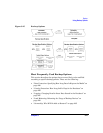
Backup
Using Backup Options
Chapter 5 233
When to Use Load
Balancing
It is recommended that you use the Load Balancing option when you
want to back up a large number of objects to a number of available
devices, and you would like Data Protector to keep all the devices busy
all of the time. You should use Load Balancing to minimize the impact
of unavailable devices on the backup. A device may become unavailable
because it:
• failed during a backup
• stopped during a backup
• is in use by another session
• cannot be started at all
When Not to Use
Load Balancing
Deselecting the Load Balancing option is recommended when
• you want to back up a small number of objects
• objects are backed up on simple devices, such as DDS
• you want to manually select the devices to which objects will be
backed up
• you want to know on which medium/media objects will be backed up
How Are the
Parameters Used?
The Load Balancing option has MIN and MAX parameters:
MIN specifies the minimum number of backup devices out of the list of
devices in the backup specification that can be used immediately. It
means that they are not used by some other backup session and that you
have enough licenses.
MAX specifies the maximum number of devices that are used at the same
time, even if there are more devices defined in the backup specification.
The rest are used if needed.
For example, assume that there are four devices in the backup
specification and MIN and MAX are both configured at two. The backup
session will queue until any of those two devices can be used. If any of
them fail, one of the two devices in reserve will be used.
How Are Objects
Assigned to an
Available Device?
The first device from the list of devices is started. The number of selected
objects for a device is defined by its concurrency. The next device is
started and objects are selected until there are no more objects in the list
or the maximum number of devices are running.
Objects to be backed up are assigned according to the following criteria:


















